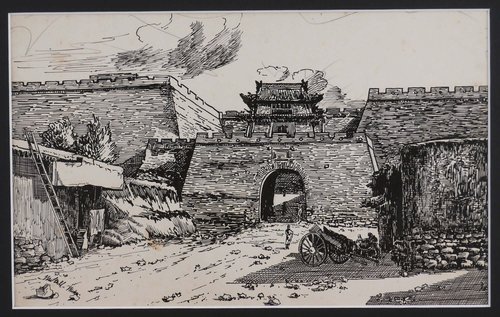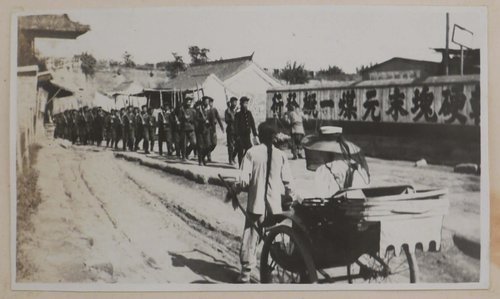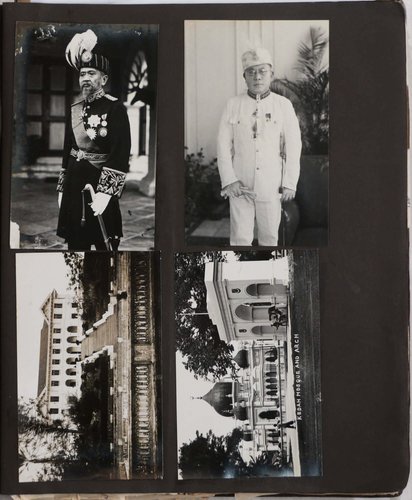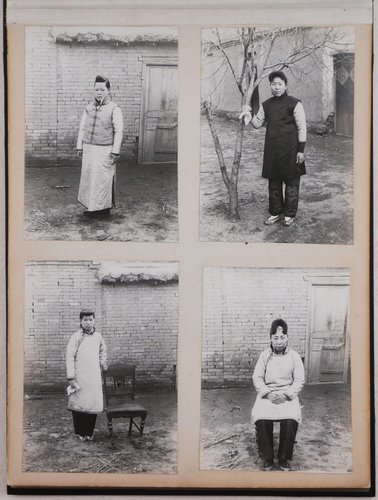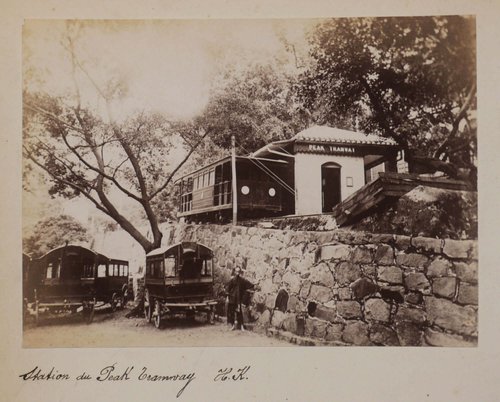







#M19
November 1903
Octavo, ca. 22,5x17,5 cm (8 ¾ x 6 ¾ in). 32 leaves. Manuscript text in French. Black and brown ink on lined white laid paper (one page written in pencil), all entries with dates on the margins. Occasional markings in red or blue pencil in text. Period style maroon half morocco album with cloth boards, spine with gilt tooled ornaments and gilt lettered title “PEKIN A HANKAO,” original paper wrappers bound in. Manuscript table of contents on verso of the front wrapper. First leaf slightly soiled on the bottom, paper slightly age toned, but overall a very good journal written in a legible hand.
Interesting historically significant journal describing a travel from Beijing to Hankou (a part of modern-day Wuhan) in November 1903; the traveller apparently was a French member of the “Société d’étude de chemis de fer en Chine,” a French-Belgian company which built the Peking-Hankou (Jinghan) Railway in 1897-1906. The construction of the Jinghan Railway started in the end of 1898, with the first sections being opened in 1899; the works were interrupted in the 1900 by the Boxer Rebellion, which led to the destruction of a large part of the railway and murder of many workers; the construction was resumed in early 1901 and finished in the end of 1905 (See more: The Peking-Hankow Railway// Bulletin of the American Geographical Society/ Vol. 38, No. 9. 1906, pp. 554-556). Although the journal entries don’t mention a year they were written, it was most likely 1903 (when the 6th of November fell on Friday, like it is recorded in the journal), a period of active construction of the remaining sections.
The journal contains a detailed account of a 16-day trip from Beijing to Hankou, along the railway under construction. Being an independent manuscript on its own, it is apparently a part of a larger collection of eight such journals, describing the whole voyage from Paris to Macao via Siberia, Manchuria, Korea, Peking, Hankou, Canton, and Hong Kong (see the table of contents on verso of the front wrapper).
The author describes his travel from Beijing along the “Imperial Route” in the “Palace car,” his visit to a monastery and a pagoda in “Tcheng Ting” (Zhengding County), which hosts a large 25m Buddha statue. He then recounts a meeting with Mr. Sémat, who owns an “exploitation” and constructs a railway between “Shum te fou” and the Yellow River. He also comments on the landscapes through which he travels by train, cart, horse and on foot: “The mountains of China are more distant, the villages more spaced out from each other; to my surprise on my left, [there is] a railway. It’s a line built by an English coal mining company, which begins from a point along the Wei Ho (Tau Kou) a little further than Wei Wei Fou and reaches the mines in the mountains, over there. This is the way through which materials for the exploitation arrived; that is also the way by which the coal will be exported; but, until now, we cannot find any…” (in translation). During his trip, he meets many people who are involved in the railway construction, including Mr. Charignon, Mr. Job, Mr. Nimal, Mr .Devienne, or Mr. Icarro: “And here comes a cavalry: it’s Mr. Nimal, the sous-chef of the Tongan Tefan section […] accompanied by his drivers and his dogs. There, in the plains, are the Tchang Té Fou walls, and before that a quay on a little river […] We then follow the West wall of the city and arrive at the section, a yamen in the west suburb near where a train station will be next year.”
There are some interesting notes on Chinese railway workers: “From time to time, teams of indigenous people, very applied in their work on the bank which they level like a billiard: the appearance, that is the strong suit of the Chinese; does the railway also have such a groomed appearance? Very curious; for example, each coolie carries such a small amount of soil at a time, but there are so many of them, and we pay them each so little!” He also discusses the benefits of the railway development: “the peasants are peaceful and in favour of the railway and sensible to the benefits they will experience […] as long as we compensate them for the fields; the houses that we are destroying, the graves that we are moving, they declare themselves very satisfied. I sense, already, that China is not deep down what we judge it to be and that its people are, like all populations, sensible to the advantages of any progress of which they can experience the effects.” Other entries tell about his sleep over in a yamen (administrative office and/or residence of a local bureaucrat or mandarin in Imperial China) in “Honntan,” an accident with his horse after which he was carried by porters, surprised Chinese officials when he presented them a passport, the hospitality of the villagers et al.: “I had forgotten to note for yesterday that we had barely gone to bed at 9pm, when a huge explosion sound made us jump, then another […] it was the village mayor’s son who came out to make fireworks in our honor.” Overall an interesting eye-witness account of the construction of the Jinghan Railway - “the first great trunk line through China” (The Peking-Hankow Railway// Bulletin of the American Geographical Society, p. 554) which in 1957 became a part of the major south-north railway in modern China – Beijing-Guangzhou Railway.








